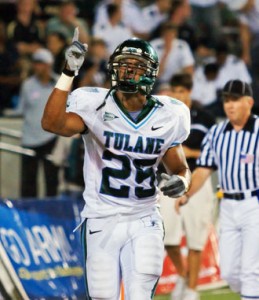Let’s flash back to December 1, 2011. At the time, Chicago Bears star Matt Forte was having the best season of his career and making a claim to being one of the league’s top five running backs. He was leading the league in yards from scrimmage. He was averaging 5.0 yards per rush. He also ranked in the top three in both receptions and receiving yards by a running back. He had gained 1,475 yards from scrimmage through 11 games, the second most in Bears history.
Forte sprained the medial collateral ligament in his right knee in week 13, costing him the remainder of the season. He has been in disputes with the Bears over his contract for the last two years, but that’s not the focus of this article today. For whatever reason, I’ve often struggled with the notion of Forte being an elite player.
Actually, I know the exact reason. There are two of them. First, Forte was not an elite running back prospect and seems to have average physical skills for a starting running back. He wasn’t a high draft pick and doesn’t have elite measurables (his 40-yard dash time was good, but his metrics in the other tests were underwhelming). This, of course, is just about meaningless when discussing a player who has been in the league for four years. Plenty of players have had average measurables and great careers at the running back position, and it’s not difficult to think of players drafted later than Forte who have turned into great backs.
Forte’s two best seasons were as much a product of workload as anything else. His rookie season he finished third in the league in touches (rushing attempts + receptions). Last year, Forte had 250 touches after 11 games, trailing only Maurice Jones-Drew (253). Of course, it’s important to remember that touches, or a heavy workload, simply by themselves, are indicators of quality, and being able to produce on a high number of touches is a very useful (and rare) skill.
So for me it comes back to wondering about that 3.6 yards per carry average in 2009. I should probably just ‘get over it.’ But I began to wonder, how rare is it for elite backs to have a down year like that? The answer is, not very rare at all.
I looked at all running backs who entered the NFL after World War II and are either (1) in the Hall of Fame, (2) have rushed for 9,000 yards, or (3) have made at least four Pro Bowls. For each of them, I noted their lowest yards per carry average in any season from ages 23 to 26 (to avoid looking at great runners before or after they hit their peak). The full list, below [1]I also eliminated all running backs with fewer than 4,000 career rushing yards, to eliminate players from different eras and blocking fullbacks, and all players who had zero seasons with at least 175 … Continue reading:
Forte rushed 258 times for 929 yards in 2009, a 3.60 yards per carry average. As you can tell, a number of other elite running backs have had a “bad” season like that. And Forte’s often been stuck running behind a below-average offensive line in Chicago, and in 2009 at least, a struggling passing game.
Forte isn’t very big, but he often plays like a power runner. He may not be very fast or shifty, but he’s able to break long runs and has an excellent jump cut. He doesn’t always look the part, but he’s been extremely productive for the Bears the past two years. Considering all the positives — Forte averaged 4.9 yards per carry last year, he’s one of only two players in history to start his career with four straight seasons of 100+ carries and 50+ catches — I think it’s probably time for me to “get over it.”
References
| ↑1 | I also eliminated all running backs with fewer than 4,000 career rushing yards, to eliminate players from different eras and blocking fullbacks, and all players who had zero seasons with at least 175 carries between the ages of 23 and 26. |
|---|---|
| ↑2 | Note: Only seasons with 175 carries were included. Crow, for example, had only one year with that many carries between the ages of 23 and 26, so his 5.85 YPC average at the age of 25 was the only season to register. |

